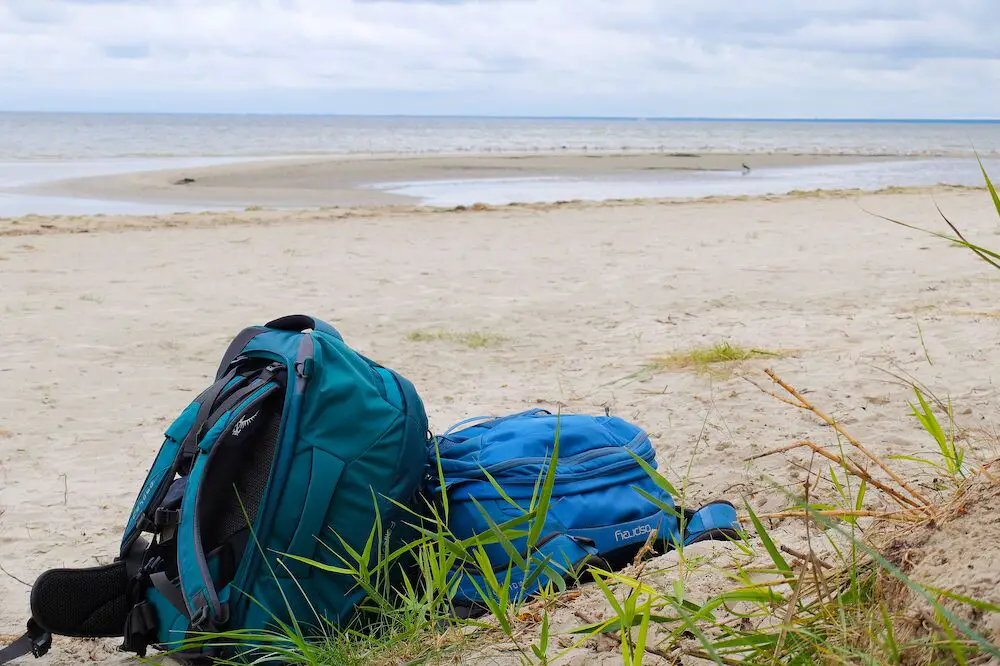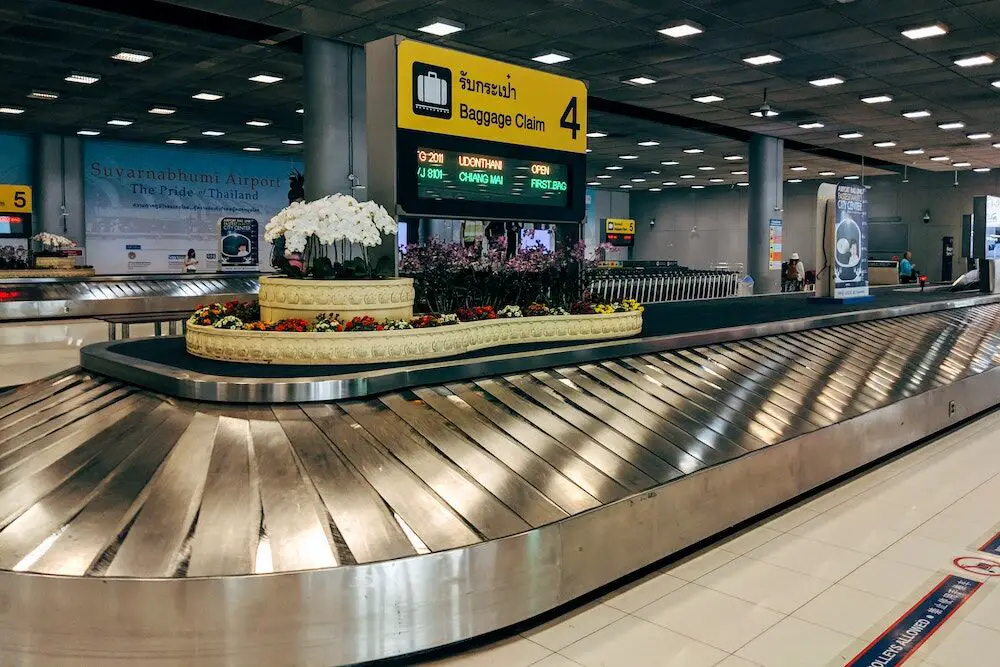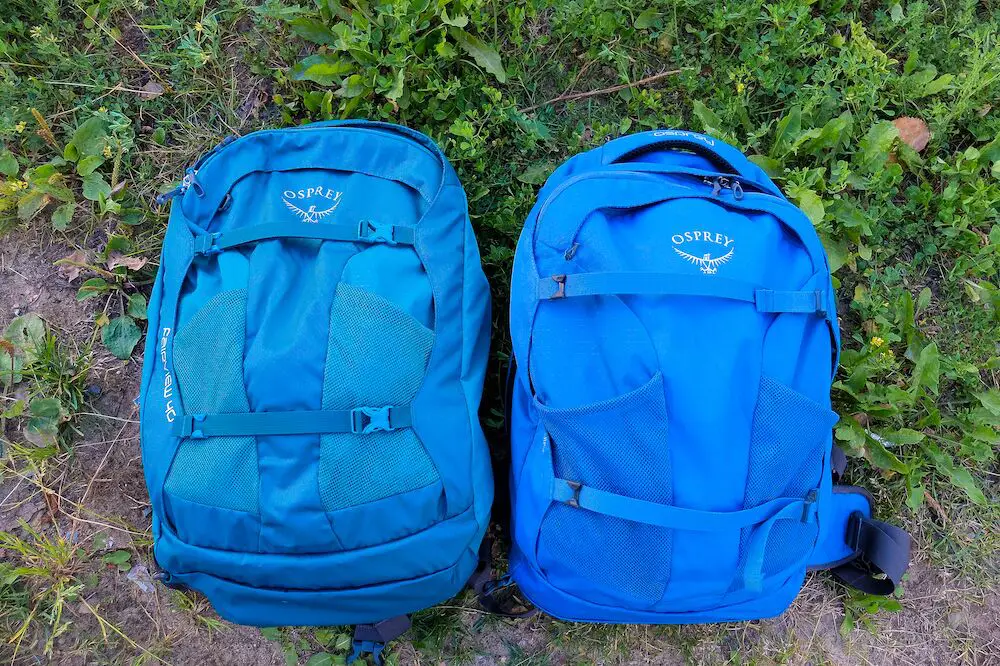What is checked baggage? Check-in baggage?
Is checked baggage free? What’s the checked baggage weight limit? What are the restrictions and rules for checked baggage in air travel? Connecting flight baggage transfer procedure with one and different airlines. These are some of the questions you will find answers to in this guide to hold luggage.
All the most popular questions about checked in baggage rules.

1. What is Checked Baggage?
In short, it’s the bag you check in with an airline.
You don’t carry it on the plane with yourself.
Checked baggage (also known as hold luggage and check in luggage) is luggage that goes in the hold of an aircraft, below the passenger deck. This luggage is inaccessible to the passenger during the flight. Unlike with carry on bag, you can’t access your checked bag during the flight.
How to check in baggage at airport? Sometimes you check in baggage at a special baggage drop counter or machine, other times you do that at the check in counter of your airline (you can get boarding passes there too). Both check-in and baggage drop counters / machines are located in the public access area of the airport (landside area).
Checking in luggage and getting boarding pass, all at the same time. It is possible. Many people choose to do so. However, it’s worth remembering, that with low-cost airlines it may also cost you extra (checking in for flight at the airport), so it’s better to do this part online — it’s super simple anyway.
What is hold luggage? Checked baggage? In air travel, it’s the bag you check in with an airline. You hand it over to be taken on the plane and stored in the hold of an aircraft. You can’t access checked bag during the flight.
Read more: Boarding Passes for Connecting Flights
1.1 Check the Baggage Tag
When a bag is checked in, it is labelled as checked baggage.
Staff at check-in counter attach a label to the side or the handle of the luggage before sending it to the the sorting office on a conveyor belt. A baggage tag is also attached to a boarding pass and given to you. If your baggage gets lost on the way, or delayed, you’ll need this tag.
On connecting flights, baggage transfer is done by airline. You check in bags and they are taken to the destination. You can see the final destination on the baggage tag — it’s a very good idea to check it, so you can have a peace of mind. This is how it works with baggage on connecting flights. It works the same way, when you have connecting flights with different airlines.
1.2 Online Check-In
Let’s assume, you have already checked in online.
If you have already checked in online, then you have to go to the baggage drop counter or machine. If there’s no baggage drop counter or machine, luggage can be checked in at a regular check-in counter. Yes, you have to go there even though you don’t need to check in for the flight anymore.

2. Is Checked Baggage Free?
Checked baggage is free quite often. But not always.
For example, it’s almost never free on low-cost airline flights. You shouldn’t expect free baggage with Wizz Air, Ryanair and easyJet.
And you should always be paying attention to what exactly you are booking with full-service airlines too. Because nowadays full-service airlines offer tickets without free checked baggage allowance too — they usually call it Economy Light, or Light Fare (more on that below).
2.1 How Much for Check-In Bag?
It depends on the airline and the weight of the bag.
Usually the price of the checked bag range from 25 EUR for shorter flights, to 60 EUR for longer flights. So, it’s not particularly cheap and if you have several flights that you have to book baggage separately, it all adds up — that’s why sometimes having self-transfer flights is not cheap at all.
If you have a round-trip flight, you pay double that.
Read more: Connecting Flights vs Self-Transfer Flights
2.2 Paying For Baggage Online vs at the Airport
As you can imagine, it’s cheaper to do it online.
If you know that you’ll be traveling with a checked bag, book baggage allowance online. It’s better to do it when you are booking a flight. It’s the cheapest option. But you can also add it later, by visiting “Manage my booking” on your airline’s website. The latter might be a bit more expensive than at the time of booking, but still cheaper than adding baggage at the airport.
You still do the baggage check in at airport, but it’s better to pay online.
3. Free Checked Baggage Allowance
Free baggage allowance varies.
Usually that’s 1 bag weighing not more than 23 kg (51 lb). Here’s one example with British Airways. This is what they allow on some of their flights – You can take 1 checked bag up to 90 x 75 x 43 cm (35.5 x 29.5 x 16 in) and 23 kg (51 lb).
But I’ll repeat — it varies. It’s not even the same on all flights of the same airline. It varies depending on the airline, travel class, ticket type and destination.
Don’t know what is the baggage allowance for your flight? Check the booking confirmation sent to your email. Or go to “Manage my booking” on the web page of your airline. Log in using your flight details, and you will see all information about your flight, like, date, time, flight number, duration, travel class, ticket type and cabin and checked baggage allowance.
When you are booking a flight, you can see baggage allowance when you are choosing the seating class (Economy, Business, etc.) and ticket type.
3.1 Checked Baggage Weight Limit
What is the weight limit for checked bags?
Normally, you can bring a bag up to around 23 kg (51 lb). In some cases, you can bring a bag weighing up to 32 kg (70 lb). For example, like Qatar Airways allow also its Economy passengers to check in bags this heavy. Max weight of checked baggage varies depending from the airline, route and some other things.
Also, remember — there’s free allowance and paid allowance.
If you pay extra, usually you’ll be allowed to bring more.

4. Connecting Flights and Checked Baggage
What happens with your checked baggage on a connecting flight?
4.1 Full-Service Airlines
Baggage rules on connecting flights with traditional airlines are simple.
In short, the traditional airline takes care of your baggage. You check in your bag once, before the first flight. You don’t have to collect and recheck your bag between flights. Unless you have a self-transfer or you are traveling through a country that requires everyone to collect and recheck their baggage (e.g., the United States). Ask the staff if you aren’t sure about the destination of your bag.
If you have a self-transfer with traditional airlines (two or more separately booked flights, with the same or different airlines), then you will need to collect and recheck your bag after every flight.
4.2 Low-Cost Airlines
Most low-cost carriers sell only direct flights, not connecting flights.
If you have a connecting flight with a low-cost carrier or carriers, often these will be self-transfer flights — two or more separately-booked flights. As with all self-transfer flights, you have to recheck baggage for every flight — that’s the biggest difference. Having to recheck baggage for every flight is no fun.
For example, Flybe doesn’t offer connecting flights. Every flight you book with Flybe is a separate flight. That’s why you have to collect and recheck baggage after each flight. If there’s passport control at the airport, you have to go through it after each flight. Take this into account when planning a layover / stopover.
However, there are a few low-cost airlines that offer connecting flights. Here are a few examples — Pegasus, Norwegian, Scoot, Air Asia and some others. When traveling with these airlines, your bag will be transferred from one plane to another by the airport staff. You won’t have to collect and recheck it after every flight. As long as the flight was booked as a single booking.
But if you have booked multiple single flights (even if it’s an airline that offers connecting flights), it will be considered a self-transfer.
4.3 Self-Transfer Flights
There are some big differences between “proper connecting flights” and self-transfer flights or DIY connections. For example, self-transfer flights are not as safe and convenient as airline-protected connecting flights.
Self-transfer is when you book two separate flights.
It can also be more than two flights. It can consist of three, four or five flights. But since it’s a DIY connection, it’s fully your responsibility. If something happens, if one flight is delayed and you miss next flight, this is your responsibility (not any of the airline’s). Just like the baggage transfer. You check in baggage for every flight separately, and you collect baggage after every flight.
You take care of baggage transfer, not the airline.
It can also be very expensive (baggage-wise). If you want to travel with checked baggage. Because you have to pay for checked baggage for every flight separately. And booking baggage for every leg can make it more expensive than if you booked a protected connecting flight.
Book protected self-transfer connection with Kiwi.
Read more:
- Baggage on Connecting Flights
- Delayed Baggage on Connecting Flights
- Lost Baggage on Connecting Flights

5. Light / Basic Economy Fare and Checked Baggage
Traditional, full-service airlines, are known for offering certain services to their customers, such as free baggage allowance. But in the last few years traditional airlines have started offering cheap flight tickets with less perks. These are so-called Economy Light tickets. These are basic tickets with almost no services that are typically offered by airlines.
Mostly, when you have an Economy Light or Basic flight, you can bring only cabin baggage. These tickets often are not refundable, and you can’t change the date and time of your departure. Also, you can’t choose a seat free of charge.
If you want to travel with a checked bag, see the next option. It might be a better idea to book a “better ticket”. Or you can add checked baggage to your Economy Light ticket. The latter option is often cheaper. However, you may want to compare the price and what you are getting for the money.
6. What if Your Checked Bag Is Too Big or Too Heavy?
What happens if your checked luggage is overweight?
What if it’s too big? If your luggage is overweight, or too big, you may have to pay extra to check it in. Alternatively, you can move some of the items into your carry-on bag (if there’s space).
6.1 How To Weight Your Bag?
If you don’t have luggage scales, use a regular scale.
If your bag is rather small, you can weight yourself first, without the bag. Then weigh yourself wearing a bag / with a bag. Subtract the difference to get the weight of your bag. With a bigger bag, you can simply weigh the bag.
If you don’t have any scales at all, you can weight your bag at the airport. Right next to every check in desk, there are conveyor scales. The weight of the bag is displayed on screen on the counter. Use check in counters that are currently empty — mostly the weights are on anyway.
The last option is not really great since you won’t know the weight until you arrive at the airport. And you won’t be able to make any big adjustments, in case your bag is way too heavy. But still, knowing what is the weight of your suitcase is better than not knowing — it makes you feel more relaxed.

7. Best Bags for Checking In
One of the best choices is soft-side luggage.
These type of suitcases are flexible yet very durable. They are usually made of durable, thick nylon with moisture-resistant coating. They look very sturdy, but, in fact, thanks to the material, soft-side suitcases are flexible enough to prevent cracking and tearing when they are handled by airport baggage handlers.
Hardside luggage is another great choice. But as it is made of hard and shiny plastics, it may scratch easily. Also many of hardside suitcases are made of less flexible materials, so they may crack more easily. When buying hardside luggage, make sure you read reviews and find out if material is durable yet flexible enough to withstand rough handling.
Large backpacks and large sports duffel bags are popular option for travelers, too. When checking in a backpack, make sure all straps are secured and all zippers closed. Tie the pack’s straps and, if possible, cover them. If you are looking for a new backpack that you are planning on checking in often, choose one with stowaway shoulder straps and harness.
This is a useful feature because the straps can be damaged on the conveyor belt. And, as you might already know, baggage handlers aren’t gentle to travelers’ luggage. Osprey Farpoint / Osprey Fairview offers a feature like this.
Also you could wrap your backpack.
This could prevent damage, too.

8. What Is Not Allowed in Checked Baggage?
There are some restrictions for checked baggage.
There are things you aren’t allowed to take on a plane at all. And then there are things you are allowed to take only in carry on bag, or only in checked baggage. For example, you aren’t allowed to carry spare lithium batteries in checked baggage. Let’s start with the things you aren’t allowed to take at all.
Some of these things are:
- Explosive materials
- Flammable items and liquids
- Chemicals, acids, gasoline, bleach and other similar substances
- Toxic and radioactive materials
- Poisons
- Gas cylinders
- Matches
- Paints and thinners
- Firelighters and lighter fuel
Allowed only in carry-on baggage:
- Power banks (allowed in carry on)
- E-cigarettes and vape pens (allowed in carry on)
- Lithium batteries. You aren’t allowed to carry spare lithium battery in checked baggage (allowed in carry on)
These rules change from time to time. And if you aren’t sure if you are allowed to bring something or not, consult your airline’s website. Or call them.
9. These Things Are Allowed in Checked Baggage
There are certain items that are not allowed in cabin bag.
However, some of them are allowed in checked baggage.
9.1 Full Size Toiletry Bottles
Are you allowed to put toiletries in your checked bag?
Yes, you are! And the good news is — you can bring toiletries of any size. Unlike with cabin baggage, you can pack full-size shampoos and shower gels in your hold luggage. You can carry safely-stored liquid in checked baggage freely.
9.2 Wine & Other Alcohol
Are you allowed to put wine in your checked bag? Yes.
You can carry liquor in checked baggage. Just make sure it’s wrapped in bubble wrap to prevent the bottle from shattering. Or use a special reusable wine bottle protector for travel, and make sure to follow the rules.
There may be limitations on how many bottles you can bring with you. But these laws depend on a country you are traveling to (and from). In some countries, alcohol is banned. So this means that you are not allowed to bring any alcohol into this country at all. Make sure you find out what are the limitations.
The same applies to all alcoholic beverages.
9.3 Sports Equipment
You can take sports equipment on a plane.
However, if you plan to carry large sports equipment like bicycle, surf board, snowboarding equipment, skiing equipment, golf equipment, diving equipment, hockey equipment, etc., you may need to book special sports equipment baggage allowance for this purpose.
Lighters in checked baggage? Disposable and Zippo lighters without fuel are allowed in checked bags.
www.tsa.gov
9.4 Laptops
You can transport laptops in checked baggage.
That’s a myth that you can’t travel with a laptop in checked baggage. What’s banned are spare batteries. You aren’t allowed to carry spare lithium battery in checked baggage (it’s allowed in carry on). But it doesn’t apply to laptops.
What is your experience with checked baggage rules? Have you ever been asked to pay extra for overweight luggage? If you have any more questions about checked baggage, write in the comments.
Featured photo by Mikhail Nilov
About the author:
Una is an organized globetrotter and foodie who’s been living a digital nomad lifestyle since 2013. She always starts her day early with a good book before diving into work. Apart from traveling and aviation, her other passions include gym, hiking and cycling. Una is also a strong proponent of AI technology. She firmly believes in its potential to simplify life and has often advocated for its wider adoption in our day-to-day activities. Her favorite airlines are Qatar Airways, Emirates, and KLM.
